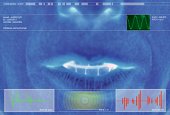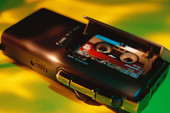|
 About
Electronic Voice Phenomena (EVPs) About
Electronic Voice Phenomena (EVPs)
(AAEVP
Member)
What is an EVP?
"Electronic Voice Phenomena (EVP) is the term traditionally used
to describe unexpected sounds or voices sometimes found on recording
media. EVP initially involved audio tape recorders, but in later
years, virtually any recording medium became a vehicle for
phenomena. The term Instrumental TransCommunication (ITC) came into
being to describe these expanded modes of audio- and video-format
communication. Other acronyms used in the literature include
Electronic Disturbance Phenomena (EDP) and Trans-Dimensional
Communication (TDC). - From
http://www.aaevp.com/"
EVPs - The Basic Facts:
Many of you have been
writing in about how to properly analyze your EVPs that you have
collected, and to ultimately make sense of what you have recorded.
There are three classes of EVPs that are commonly associated with
the recordings:
Class A EVPs are voices that you can understand, and can be heard by
most all people over a speaker or headphones.
Class B EVPs are trickier, because they can be heard on the
recording, or on the speaker/headphones, but there is varied
opinions as to what the EVP says. For example, one might hear
"I'm alone" while another might here, "I am at home."
Class C EVPs are recordings that can only be heard over headphones,
and are very difficult to distinguish. An example may be a
faint flicker of voices or noises, such as changing the channel fast
on your television with the sound barely audible.
It is debated among paranormal researchers that
Electronic Voice Phenomena occurs "at best" in the 0 (Zero) to 80
(Eighty) Hz range. The human voice allegedly (but debated) cannot go below 80 Hz, and
so anything below that is not produced by the vocal chords of a
human being. EVPs can be found between the 0 (Zero) and (300)
Three Hundred Hz range, but the most accurate are found between 0
and 80 Hz. White noise, (pertaining to the noise not the
movie) contains all the frequencies of sound that the human ear can
detect. So, many people use white noise in the background
while recording their EVPs to record actual Electronic Voice
Phenomena.
A human voice can create frequencies as low as 300 Hz and as high as
3000 Hz. Any voice that is recorded below 300hz or above 3000hz is
popularly considered by most paranormal researchers an EVP.
Don't be confused with all of the scientific jargon and debate
behind which frequencies are more "accurate," just keep in mind that
the human voice is capable of various frequencies, and if you go
below or above the ranges described above in the article, then you
can better pinpoint the validity of the EVP.
The use of white noise, while debatable by many people who study and
record EVPs - allegedly aides the person recording EVPs to make the
"ghostly transmissions" more audible. However, it also may
assist in matrixing of "ghostly transmissions," meaning that a
person may hear something generated by the white noise itself, and
not something paranormal.
To dive deep into the theories of EVPs, we need to look at what many
people explain to be - why EVPs occur. Some believe that
spirits communicate on a frequency beyond our capacity to hear,
which is really interesting to me - considering that recently a
ringtone called "Mosquito
Stealth" was put on the market that aided teenagers to
receive phone calls during class. The ringtone is only audible
to teenagers, and adults cannot hear it - because over time, age
causes slight loss of hearing, and younger people can hear at a
frequency range that adults cannot. This example can apply to
EVPs, in part by the fact that ghosts or spirits could be able to
communicate with the living if our listening capacity was greater
than it biologically is. Theories range from spirits using our
energy or the white noise to "pass through" onto the recording, or
simply that the recording itself allows us to pick up what the human
ear cannot. Whatever the theory, all agree that the phenomena
does indeed occur.
 EVPs
- The Proper Way To Record: EVPs
- The Proper Way To Record:
Techniques vary based on the source. I have found no
problems using a digital voice recorder or tape recorder with no
white noise or other sound present. Other people require a
fan, water fountain, or other "white
noise source" in the background to record their EVPs.
My suggestions for recording EVPs are as follows:
1. Get a good quality cassette or digital recorder.
2. Record in a space where you have no external distractions that
could be mistaken for an EVP.
3. Ask clear questions, and log the timestamp of when you asked the
questions.
4. Have the ability to import your recordings into a computer for
analysis.
5. Listen to, playback, and analyze your recording.
6. Measure the frequency of the recording for accuracy and validity.
7. Log and document your findings.
The most important thing to note is that when recording an EVP, you
do NOT want to expect results right away. EVPs can take time
to capture, and you may have to listen to hours of nothing before an
EVP will "pass through." Indeed, if you have the patience and
the determination to acquire such phenomena - it will occur.
Scientifically speaking, I suggest your analysis of the EVP - once
captured - be your primary determination of it's validity - not the
recording itself.
 EVPs
- How To Analyze An EVP: EVPs
- How To Analyze An EVP:
Many MANY of you are writing in about the analysis of EVPs.
While this varies (software, tools, preferences..... so many tools,
so little time...) all depend on two things. Budget, and
sophistication. I use the following for my EVP Analysis:
1. Acid Studio Pro: This is used to import the EVP, and then
to isolate the EVP, edit the file, and generate a new file with the
EVP alone. I also use this to slow down, reverse, and change
the speed of the recording to further analyze what is being said.
Many of my EVP analysis submissions below use this technique.
Some people use Audacity ( A free program to edit, produce noise
reduction) which can be downloaded
free here.
2. Noise reduction. There are several software programs which
remove the excess noise from .wav files, and allow for better
clarity of the EVP. Audacity has a noise reduction plug-in,
you can download Audacity
free here!
3. Frequency Analysis: I have searched the WEB over to find a
good package that provides a visual spectrum for audio files.
Some of them have averaged between $100 - $299.00! If your
like me, you don't have that kind of money - right? Well, I
did find a great software program for FREE on the Internet you can
use.
You can download this FREEWARE program here.
NOTE: All links on this page are THIRD PARTY! The
Louisville Ghost Hunters Society does NOT accept any responsibility
for the downloading of these software products. Please
download and use all programs at your OWN RISK!
4. Once you have grasped the use of the EVP analysis software, and
have isolated your EVP - you can then determine the validity of the
recording. It will be time consuming, but very educational to
dive into the world of EVP recording an analysis, but one which I
think you will find most enjoyable - if you are into the paranormal!
Below is The Louisville Ghost Hunters Society EVP analysis records.
You can access each record by clicking the link to open a new
window. This will show a flash player, which upon completion
of loading the audio file will display a PLAY/STOP button and a
animation that reads "EVP Analysis." If you do not see those
buttons or animation, your player is still loading.
The documentation and spectrogram will be displayed along with the
audio file. Please note that all images may not be the same
after analysis, this is common as sometimes the EVP may change after
noise reduction, speed changes, etc.
Also note that any EVPs submitted to The Louisville Ghost Hunter
Society become the property of The Louisville Ghost Hunters Society,
and will be displayed on this page for review. Analysis of
your EVP may take 2-4 weeks for completion. If you have an EVP
you would like us to analyze, please e-mail Keith Age directly at:
kage@louisvilleghs.com.
I hope you enjoy your exploration of EVPs, and I look forward to
working towards the exploration of this unique and fascinating field
of audio phenomena.
Sincerely,
AAEVP Member in 2006
The Louisville Ghost Hunters Society
|